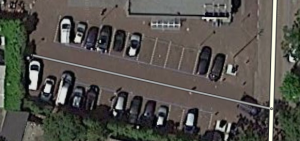(Marked this version for translation) |
mNo edit summary |
||
| Line 34: | Line 34: | ||
<!--T:8--> | <!--T:8--> | ||
For [[#Restricted|restricted]] and [[#Private|private]] parking lots a name is mandatory. Otherwise those parkings don't show up in the search results. On the app map they are greyed out. Without a name they can't be found en would be useless.{{Clear}} | '''For [[#Restricted|restricted]] and [[#Private|private]] parking lots a name is mandatory'''. Otherwise those parkings don't show up in the search results. On the app map they are greyed out. Without a name they can't be found en would be useless.{{Clear}} | ||
===Kiss and Ride, Park and Ride=== <!--T:13--> | ===Kiss and Ride, Park and Ride=== <!--T:13--> | ||
Latest revision as of 09:01, 27 October 2020

Parking Lot Places are always drawn as an Area Place. It is a sub-category on its own. A Parking Lot Place should be a distinctly-marked area where cars can park, separated from the road and with its own drive-able segments. On-street parking (parking spots directly accessible from the road) should not be mapped, independent of car park signs being present.
Parking Lot Road segments should be added, but only the minimal amount required to allow navigation into and out of the car park.
Distinctive and Significant
Overuse of Area Places quickly leads to map clutter. A Parking-Lot Area Place must mark a parking facility that would be distinctive and significant to passing drivers, including those not seeking parking. Parking that does not satisfy this principles shall not be marked with the Parking Lot Area Place.
Primary lot type
- Public is the default parking lot type. A public parking lot is open to everyone during opening hours, for at least short-term use (paid or not). People who park here are entitled to exit and enter this area no matter where they go.
- Restricted is used for parking areas where restrictions apply, like only for customers, visitors of a nearby place, etc.. Restricted parking lot places are - at the moment - not showing up in the search results / are not presented as alternative parking. If it is important that they do show up in search results, better keep it "Public type and indicate the restriction in the name, e.g., [P] Patients Oncology.
- Private: only accessible to a specific group (residents, employees, ...). Private parkings never show up in the search results.
Parking Lots Names
Use the commonly used name such as “Quick Parking Zaventem”. Names like "Parking de l’Hôpital Saint-Luc" could be used for restricted parking lots.

Do not use completely generic names such as "Parking" or "Public Parking" for anonymous parking facilities. If a Parking Lot has no specific name, leave the name field empty, but don't forget to set the street and city fields. This should be the road where the (main) entrance of the parking lot is. This way when you search for a parking in the app you can see the difference between the Parking Lots and it won't fill the map with unnecessary names.
In case the parking belongs to an existing Place, [P] or Parking can be added in front of the Place name, so it is easy to distinguish between the Place itself and the parking place belonging to that Place, like Parking UZA - Bezoekers. If a parking lot place has no name, don't add a [P] either.
For restricted and private parking lots a name is mandatory. Otherwise those parkings don't show up in the search results. On the app map they are greyed out. Without a name they can't be found en would be useless.
Kiss and Ride, Park and Ride
For Kiss and Ride locations you can use a Parking Lot place with a name like [K+R] followed by a < name >. In the same manner a Park and Ride location can be defined: [P+R] followed by a < name >.
Locking
As Parking Lots are important for Waze routing, the Area Places should be locked to Level 2 at least.
More info
Specify as much as possible the parking attributes. However, leave the house number attribute empty.
Examples
-
This separate parking area should be mapped
-
This is on-street parking and should not be mapped

